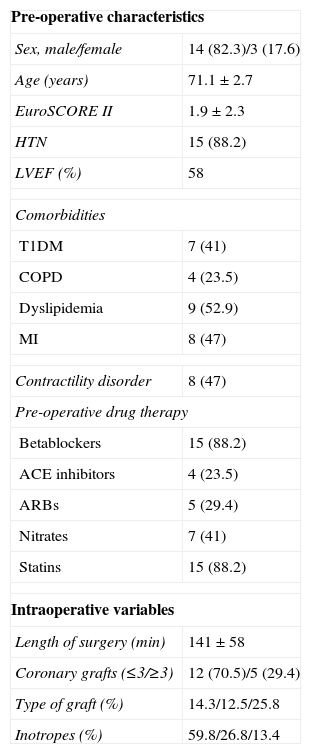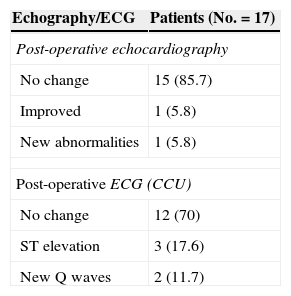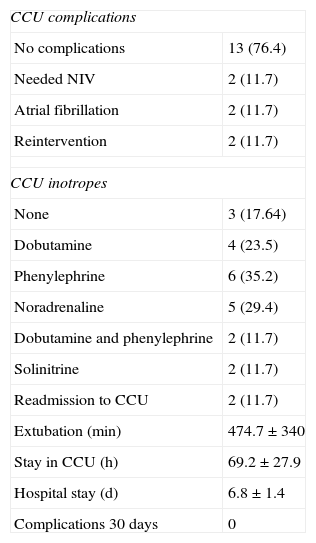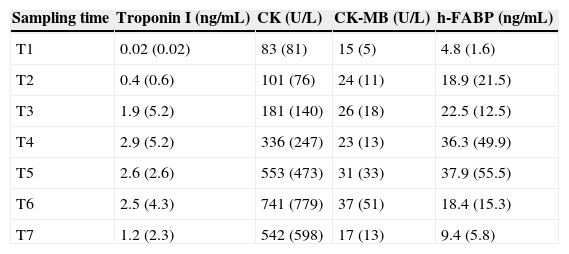Postoperative myocardial infarction is a serious and frequent complication of cardiac surgery. Nonetheless, diagnosis in this context is occasionally challenging. We sought to evaluate the kinetics and diagnostic accuracy of the new biomarker “heart-type fatty acid-binding protein” (h-FABP) in the early detection of myocardial injury in patients undergoing off-pump coronary artery bypass grafting, compared with classical biomarkers.
Materials and methodsA prospective study was conducted on 17 consecutive patients who underwent off-pump coronary artery bypass grafting during a 2-month period. Blood samples were drawn for measurement of myocardial ischemic injury biomarkers (h-FABP, troponin, creatine kinase [CK] and CK-MB), at baseline (T1), immediate post-coronary artery bypass grafting (T2), on ICU admission (T3), and after 4 (T4), 8 (T5), 24 (T6) and 48h (T7). Perioperative ischemic complications, defined according to electrocardiographic, echocardiographic and hemodynamic criteria, were recorded.
ResultsEarlier peak biochemical marker plasma values occurred at T4 with troponin (2.9±5.2ng/mL), and at T5 with h-FABP (37.9±55.5ng/mL). Maximum values of CK and CK-MB occurred later, both in T6 (741±779 and 37±51U/L, respectively). The optimized cut-off obtained for h-FABP was 19ng/mL, providing a sensitivity and specificity of 77 and 75%, respectively, for diagnosis of perioperative ischemic injury, with an area under the ROC curve for h-FABP of 0.83 (95% CI 0.6–1.0) vs. 0.63 (95% CI 0.33–0.83) for troponin. This cut-off value for h-FABP is reached on average at T2 (mean value of h-FABP at T2: 18.9±21.5ng/mL).
ConclusionThis is the first study evaluating the kinetics of h-FABP biomarker in perioperative off-pump coronary artery bypass grafting, and the cut-off value established could help to extend earlier detection of myocardial ischemia in this context.
El infarto de miocardio posoperatorio es una complicación grave y frecuente de la cirugía cardiaca. El diagnóstico en este contexto es, en ocasiones, difícil. El objetivo de este estudio es evaluar la cinética y la precisión diagnóstica de un nuevo marcador, la heart-type fatty acid-binding protein (h-FABP), en la detección precoz de daño miocárdico en pacientes sometidos a cirugía de revascularización coronaria sin circulación extracorpórea en comparación con los biomarcadores clásicos.
Materiales y métodosSe estudiaron prospectivamente 17 pacientes consecutivos sometidos a cirugía cardiaca de revascularización sin circulación extracorpórea. Se analizaron biomarcadores de lesión de isquemia miocárdica (h-FABP, troponina, creatincinasa [CK] y CK-MB) al inicio de la cirugía (T1), inmediatamente después de la revascularización (T2), al ingreso en la UCC (T3) y después de 4 (T4), 8 (T5), 24 (T6) y 48h (T7). Se registraron las complicaciones isquémicas perioperatorias, definidas de acuerdo con criterios electrocardiográficos, ecocardiográficos y hemodinámicos.
ResultadosLos valores plasmáticos pico de la troponina se alcanzaron en T4 (2,9±5,2ng/ml) y en T5 con h-FABP (37,9±55,5ng/ml). Los valores máximos de CK y CK-MB fueron más tardíos, en T6 (741±779 y 37±51U/L, respectivamente). El punto de corte obtenido para h-FABP para la detección de eventos isquémicos fue de 19ng/ml, proporcionando una sensibilidad y especificidad del 77 y 75%, respectivamente, para el diagnóstico de la lesión isquémica perioperatoria, con un área bajo la curva ROC para h-FABP de 0,83 (IC 95% 0,6-1,0) vs. 0,63 (IC 95% 0,33-0,83) para troponina. Se alcanza este valor de corte para la h-FABP en promedio en T2 (18,9±21,5ng/ml).
ConclusiónEste es el primer estudio que evalúa la cinética del biomarcador h-FABP en el perioperatorio de la cirugía de revascularización sin circulación extracorpórea, y el valor de corte establecido podría ayudar a la detección temprana de la isquemia miocárdica en este contexto.












